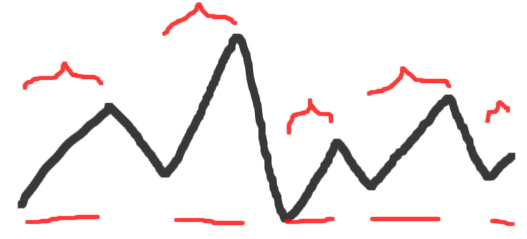Buy and Sell Stock (LeetCode 121, 122, 123, 188, 309, 714)
1. 简介
本文对LeetCode中”Best Time to Buy and Sell Stock”系列进行总结,题目包括:
- [LeetCode 121] Best Time to Buy and Sell Stock
- [LeetCode 122] Best Time to Buy and Sell Stock II
- [LeetCode 123] Best Time to Buy and Sell Stock III
- [LeetCode 188] Best Time to Buy and Sell Stock IV
- [LeetCode 309] Best Time to Buy and Sell Stock with Cooldown
- [LeetCode 714] Best Time to Buy and Sell Stock with Transaction Fee
通过链接能查阅得到题目描述,在此不赘述。
2. Buy and Sell
从最基本的情形出发:给定一维数组表示股票每天的价格,寻找利润最多的一段时间,并返回最大金额。
思路:
- 动态规划
- 贪心
2.1 动态规划
\(dp[i]\)表示从第0天~第\(i\)天最多能挣多少钱
状态转移方程:\(dp[i] = max(dp[i-1], prices[i] - minPrice)\)
其中\(prices[i]\)表示第\(i\)天价格,minPrice表示第0天~第\(i\)天最低价格
不难理解:第0天~第\(i\)天能挣最多的钱,要不就是从某个最低点买入并在第\(i\)天卖出,要不就是第0天~第\(i-1\)天能挣的钱。
时间复杂度:\(O(n)\)
空间复杂度:\(O(n)\)
class Solution {
public:
int maxProfit(vector<int>& prices) {
if(prices.size() == 0 || prices.size() == 1)
return 0;
// DP
// dp[i] represent the maximum profit from day 0 to day i
// dp[i] = max(dp[i-1], prices[i] - minPrice)
// Time: O(n)
// Space: O(n)
int minPrice = prices[0];
vector<int> dp(prices.size(), 0);
for(int i=1; i<prices.size(); i++){
dp[i] = max(dp[i-1], prices[i] - minPrice);
if(prices[i] < minPrice)
minPrice = prices[i];
}//for
return dp[prices.size() - 1];
};
2.2 贪心
在使用动态规划求解过程中,使用了一维数组来存储从第0天到第\(i\)天每天的最大利润,这是不必要的,我们只需要得到最后一天能挣多少钱,将上述过程简化为贪心即可避免中间变量存储。
使用变量记录当前最大利润,计算每天最大利润后,更新变量。循环完毕后,该变量即为最终结果。
时间复杂度:\(O(n)\)
空间复杂度:\(O(1)\)
class Solution {
public:
int maxProfit(vector<int>& prices) {
if(prices.size() == 0 || prices.size() == 1)
return 0;
// Greedy
// Time: O(n)
// Space: O(1)
int minPrice = INT_MAX;
int maxProfit = 0;
for(int i=0; i<prices.size(); i++){
if(prices[i] < minPrice)
minPrice = prices[i];
else
maxProfit = max(maxProfit, prices[i] - minPrice);
}//for
return maxProfit;
}
};
3. Buy and Sell II
这道题比第一题多了些条件:1. 允许进行多次买卖;2. 多次买卖之间不能重合,即必须卖出去了才能买下一个股票。

题目经过更改后,反而更简单了。如上图所示,如果能够进行多次买卖,只需要把所有涨的部分买下来就可以了。
思路是寻找所有增长的区间,实际上等于找数组中相邻两个数字是上升的所有数字对,将它们的差求和。
时间复杂度:\(O(n)\)
空间复杂度:\(O(1)\)
class Solution {
public:
int maxProfit(vector<int>& prices) {
int ans = 0;
for(int i=1; i<prices.size(); i++){
if(prices[i] > prices[i-1])
ans += prices[i] - prices[i-1];
}//for
return ans;
}
};
4. Buy and Sell III
这道题相比于第二题修改了第1个条件:最多只能进行2次交易,不再是无限次了。
这题的解题思路要从第一题的动态规划法出发:在第一题的动态规划法中使用了一维数组记录了从第0天到第\(i\)天的最大利润,如果能够进行两次买卖的话,那么思考如下场景:A点买入,B点卖出,C点(在B点后)买入,D点卖出。其中A买B卖的过程可以用第一题的动态规划数组记录下来,C买D卖的过程怎么获得呢?答案仍然是动态规划。但是数组dp[i]记录的是从第\(i\)天到最后一天能够最大利润。
所以,这道题用两次DP可以解决:
- 第一次DP:与第一题一样,\(dp1[i]\)表示从第0天~第\(i\)天最多能挣多少钱;
- 第二次DP:反方向DP,\(dp2[i]\)表示从第\(i\)天到最后一天能够最大利润;
最多进行两次交易获得最大利润为:\(max(dp1[i] + dp2[i+1]) for \ i \ in \ range(0, n)\)
时间复杂度:\(O(2*n)\)
空间复杂度:\(O(2*n)\)
class Solution {
public:
int maxProfit(vector<int>& prices) {
if(prices.size() <= 1)
return 0;
int ans = 0;
int inOrder[prices.size()+1], minnum = prices[0];
memset(inOrder, 0, sizeof(inOrder));
for(int i=1; i<prices.size(); i++){
inOrder[i] = max(prices[i] - minnum, inOrder[i-1]);
if(prices[i] < minnum)
minnum = prices[i];
}//for
int reOrder[prices.size()+1], maxnum = prices[prices.size()-1];
memset(reOrder, 0, sizeof(reOrder));
for(int i=prices.size()-2; i>=0; i--){
reOrder[i] = max(maxnum - prices[i], reOrder[i+1]);
if(prices[i] > maxnum)
maxnum = prices[i];
}//for
ans = inOrder[prices.size()-1];
for(int i=0; i<prices.size()-1; i++)
ans = max(ans, inOrder[i] + reOrder[i+1]);
return ans;
}
};
5. Buy and Sell IV
这一题再对第三题进行泛化,求最多交易k次最大利润。此时仍然使用动态规划解决:
- 在某个时间点买入相当于减掉当天的价格,在某个时间点卖出相当于加上当天的价格,在第\(i\)天买第\(j\)天卖,利润为\(-prices[i] + prices[j]\)。
- \(localMax\)记录到目前为止,仍持有股票没有卖出状态下的最大利润。
- \(dp[i][j]\)表示从第0天到第\(i\)天,使用\(j\)次交易能达到的最大利润,此时交易已完成,不持有股票。
- 状态转移方程:\(dp[i][j] = max(dp[i-1][j], prices[i] + localMax)\)
不难理解,\(dp[i][j]\)表示完成了\(j\)次交易(重要),此时有两种可能:1. 第\(i\)天不交易(不买不卖),利润为\(dp[i-1][j]\);2.第\(i\)天卖出,利润为\(prices[i] + localMax\)。\(localMax\)记录的是在第0天到第\(i-1\)天某天买入的最大利润(使用\(j-1\)次交易),第\(i\)天卖出后就完成了第\(j\)次交易。
那么在第\(i\)天买入的情况呢?答案是用\(localMax\)来记录。\(localMax = max(localMax, dp[i-1][j-1] - prices[i])\),该式表示第0天到第\(i-1\)天的交易完成情况下的最大利润,加上第\(i\)天买入,如果此时得到的钱是最多的,那么记录下来,在未来的某个日子卖掉该股。\(localMal\)计算的式子理解为:尝试一下在第\(i\)天开启第\(j\)次交易,看看有没有可能获得更大的列润,所以它是用\(dp[i-1][j-1]\)的值来减去\(prices[i]\)。
此题有一个细节,如果\(k\)大与总天数的一半,那么相当于可以任意买卖,最大利润计算方法回到第二题。
时间复杂度:\(O(k*n)\)
空间复杂度:\(O(k*n)\)
class Solution {
public:
int maxProfit(int k, vector<int>& prices) {
if(k == 0 || prices.size() <= 1)
return 0;
if(k >= prices.size() / 2)
return getMaxProfit(prices);
/*
Buying a stock is equivalent to subtracting the price of that day.
Selling a stock is equivalent to adding the price of that day.
Suppose that you buy on day i and sell on day j, the profit
will be -prices[i] + prices[j].
localMax means that the maximum profit until now with one
stock waiting to be sold.
dp[i][j] means that the maximum profit from day 0 to i
using j transaction.
dp[i][j] = max(dp[i-1][j], prices[i] + localMax)
*/
int dp[prices.size()+1][k+1], localMax;
memset(dp, 0, sizeof(dp));
for(int j=1; j<=k; j++){
localMax = -prices[0]; // Buy on day 1 (the stock waiting to be sold)
for(int i=1; i<prices.size(); i++){
dp[i][j] = max(dp[i-1][j], prices[i] + localMax);
localMax = max(localMax, dp[i-1][j-1] - prices[i]); // Buy on day i
}//for
}//for
return dp[prices.size()-1][k];
}
int getMaxProfit(vector<int>& prices){
int ret = 0;
for(int i=1; i<prices.size(); i++){
if(prices[i] > prices[i-1])
ret += (prices[i] - prices[i-1]);
}//for
return ret;
}
};
6. Buy and Sell with Cooldown
此题目在第二题的基础上增加条件,第\(i\)天卖出后,第\(i+1\)天要休息一下(Cooldown)。
动态规划:
- \(dp[i]\)表示从第0天到第\(i\)天的已经Cooldown过的最大利润,\(i+1\)天可以买入了。
- \(localMax\)表示到现在为止,手上持有股票等着卖出的最大利润。
- 状态转移方程:\(dp[i] = max(dp[i-1], prices[i-1] + localMax)\)
不难理解,第\(i\)天的最大利润有两种可能:1. 今天不交易了;2. 在\(i-1\)天的时候卖了,第\(i\)天休息一下。
时间复杂度:\(O(n)\)
空间复杂度:\(O(n)\)
class Solution {
public:
int maxProfit(vector<int>& prices) {
if(prices.size() <= 1)
return 0;
/*
dp[i] means that the maximum profit with cooldown.
You can buy day i+1 now.
localMax means that the maximun profit until now
with one stock waiting to be sold.
*/
int dp[prices.size()+2], localMax = -prices[0]; // Day 0 waiting to be sold
memset(dp, 0, sizeof(dp));
for(int i=2; i<prices.size()+1; i++){
dp[i] = max(dp[i-1], prices[i-1] + localMax); // Sell on day i-1, cooldown on day i
localMax = max(localMax, dp[i-2] - prices[i-1]); // Buy on day i-1
}//for
return dp[prices.size()];
}
};
7. Buy and Sell with Transaction Fee
这一题是从第二题引申过来的,即可以无限买卖,但是买卖存在手续费,如果买卖赚的钱还不够手续费,那么这次买卖就不必要了。
从第一题的贪心算法出发思考:每一次考虑卖出时,都要计算卖出后的钱能不能抵回手续费。
时间复杂度:\(O(n)\)
空间复杂度:\(O(1)\)
class Solution {
public:
int maxProfit(vector<int>& prices, int fee) {
if(prices.size() <= 1)
return 0;
int ans = 0, minPrice = prices[0];
for(int i=1; i<prices.size(); i++){
if(prices[i] < minPrice)
minPrice = prices[i];
else if(prices[i] > minPrice + fee){ // can be sold
ans += prices[i] - minPrice - fee;
minPrice = prices[i] - fee; // avoid duplicative subtraction
}//if-else
}//for
return ans;
}
};